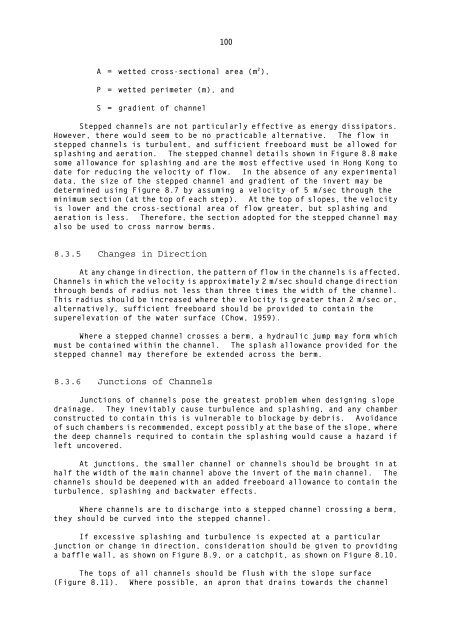Geotechnical Manual for Slopes
Geotechnical Manual for Slopes
Geotechnical Manual for Slopes
Create successful ePaper yourself
Turn your PDF publications into a flip-book with our unique Google optimized e-Paper software.
100<br />
A = wetted cross-sectional area (m 2 ),<br />
P = wetted perimeter (m), and<br />
S = gradient of channel<br />
Stepped channels are not particularly effective as energy dissipators.<br />
However, there would seem to be no practicable alternative. The flow in<br />
stepped channels is turbulent, and sufficient freeboard must be allowed <strong>for</strong><br />
splashing and aeration. The stepped channel details shown in Figure 8.8 make<br />
some allowance <strong>for</strong> splashing and are the most effective used in Hong Kong to<br />
date <strong>for</strong> reducing the velocity of flow. In the absence of any experimental<br />
data, the size of the stepped channel and gradient of the invert may be<br />
determined using Figure 8.7 by assuming a velocity of 5 m/sec through the<br />
minimum section (at the top of each step). At the top of slopes, the velocity<br />
is lower and the cross-sectional area of flow greater, but splashing and<br />
aeration is less. There<strong>for</strong>e, the section adopted <strong>for</strong> the stepped channel may<br />
also be used to cross narrow berms.<br />
8.3.5 Changes in Direction<br />
At any change in direction, the pattern of flow in the channels is affected.<br />
Channels in which the velocity is approximately 2 m/sec should change direction<br />
through bends of radius not less than three times the width of the channel.<br />
This radius should be increased where the velocity is greater than 2 m/sec or,<br />
alternatively, sufficient freeboard should be provided to contain the<br />
superelevation of the water surface (Chow, 1959).<br />
Where a stepped channel crosses a berm, a hydraulic jump may <strong>for</strong>m which<br />
must be contained within the channel. The splash allowance provided <strong>for</strong> the<br />
stepped channel may there<strong>for</strong>e be extended across the berm.<br />
8.3.6 Junctions of Channels<br />
Junctions of channels pose the greatest problem when designing slope<br />
drainage. They inevitably cause turbulence and splashing, and any chamber<br />
constructed to contain this is vulnerable to blockage by debris. Avoidance<br />
of such chambers is recommended, except possibly at the base of the slope, where<br />
the deep channels required to contain the splashing would cause a hazard if<br />
left uncovered.<br />
At junctions, the smaller channel or channels should be brought in at<br />
half the width of the main channel above the invert of the main channel. The<br />
channels should be deepened with an added freeboard allowance to contain the<br />
turbulence, splashing and backwater effects.<br />
Where channels are to discharge into a stepped channel crossing a berm,<br />
they should be curved into the stepped channel.<br />
If excessive splashing and turbulence is expected at a particular<br />
junction or change in direction, consideration should be given to providing<br />
a baffle wall, as shown on Figure 8.9, or a catchpit, as shown on Figure 8.10.<br />
The tops of all channels should be flush with the slope surface<br />
(Figure 8.11). Where possible, an apron that drains towards the channel

















